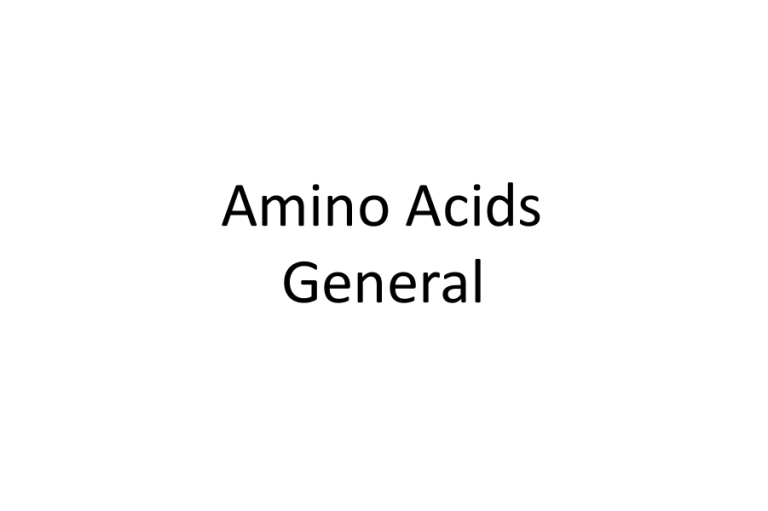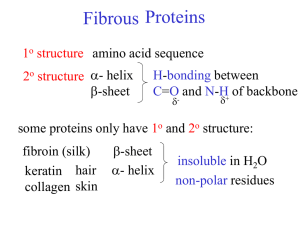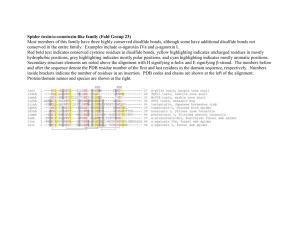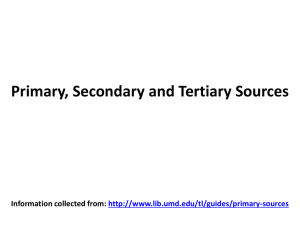Document
advertisement

Amino Acids General Amino Acids: • Building blocks for peptides, proteins • Some individually important (or converted to important molecules) • Gly, Glu, Tyr neurotransmitters • Tyr parent/precursor for epinephrine (adrenaline) • His stomach secretes HCl, symptoms for inflammation, colds. • Essential (10) • needed for normal health • not synthesized by the body • must be supplied by diet • Complete (animal) vs. Incomplete (vegetable) protein Amino Acids Structure Amino Acid Structure: • Amide, CA, R-group (variable) • D/L Isomers Amino Acids Side Chains AA – Side Chains: • Side chains determine the functionality of the AA b/c the –COOH and –NH2 groups react to form the backbone • 3 letter abbreviations (given on cheat sheet) Classification Functional Group Property Nonpolar -R (aliphatic or aromatic) Hydrophobic Polar -COOH, -NH2, -OH Hydrophilic Acidic -COOH (extra) Lose H2 anion Salt Bridges Basic -NH2 (extra) Gain H2 cation Salt Bridges Zwitterion Zwitterion: dipolar form of AA, found at biological pH’s (internal acid/base Rxn) Amphoteric Amphoteric: molecules with properties of both acid and base Formation of Polypeptides Formation Reaction: • Dehydration reaction • CA + Amine Amide • Amide structure/Peptide bond/Peptide linkage Amide/Peptide Bonds Polypeptides Polypeptides: • Small chains of AA (40-50 units) • Many ways to connect together (N!) • ~30 biologically relevant ones • Hormones or Nerve transmitters • Small changes structure HUGE changes in functionality Protein Structure Proteins – General: • > 50 AA • Linus Pauling – 1954 Nobel Prize α-helix and β-pleated sheet • Fredrick Sanger – 1958 Primary structure of beef insulin Classification Primary Description #, kind, type and sequence of AA Secondary Regular 3D structure, held together by H-bonds in backbone Tertiary Distinct 3D structure due to interactions between R-groups Quaternary Complex proteins Examples α-helix β-pleated sheet triple helix H-bonds Ionic bonds (Salt Bridges) Disulfide bonds Hydrophobic Hydrophilic Multiple units Non-protein parts Metal ions Primary Structure Primary Structure: • #, kind, type, and sequence of AA • Fredrick Sanger (1958 Nobel Prize) Beef Insulin • Several years of work to sequence 51 AA • Hydrolyzed proteins into smaller fragments to analyze Fragment 1: Gly-Glu-Arg-Gly-Phe-PheGly-Phe-Phe-Tyr-Thr-Pro-Lys Fragment 2: Combined: Gly-Glu-Arg-Gly-Phe-Phe-Tyr-Thr-Pro-Lys Overlap • Edman Degradation – split AA at N-Terminal End Secondary Structure Secondary Structure: • Determined by H-bonds between AA-backbone • α-helix AA 4 residues apart, R-groups towards outside • β-pleated sheet AA far apart, R-groups face outwards Tertiary Structure Tertiary Structure: • Determined by interactions between R-groups • H-bonds: -COOH and –OH • Ionic/Salt Bridges • Disulfide Bonds • Hydrophobic (form core of protein) • Hydrophilic (face outwards to interact with water) Quaternary Structure Quaternary Structure: • Multiple protein units • Non-protein parts • Metal ions • Ex: Hemoglobin • 4 subunits • Fe atoms Protein Structure Summary α-Helix α-helix Structure: • Secondary • Determined by H-bonds between AA-backbone • α-helix AA 4 residues apart, R-groups towards outside β-Pleated Sheet β-pleated sheet structure: • Secondary • Determined by H-bonds between AAbackbone • β-pleated sheet AA far apart, Rgroups face outwards H-bonds Secondary H-bonds: • Between the C=O and NH of backbone • Responsible for secondary structure Tertiary H-bonds: • Between the C=O and -NH or -OH of R-groups • Responsible for tertiary structure Salt Bridges Ionic Bonds/Salt Bridges: • Tertiary Structure • Between –COO- and –NH3+ groups Disulfide Bonds Disulfide bonds: • Tertiary Structure • Between -SH and –SH groups • Mainly between Cys-Cys Hydrophobic Interactions Hydrophobic Interactions: • Tertiary Structure • Between –R groups (Alkane and Aromatic) • Interior of proteins to avoid water Hydrophilic Interactions Hydrophilic Interactions: • Tertiary Structure • Exterior of proteins to interact with water • Polar groups (OH) • Acidic groups (COOH) • Basic groups (NH2) Identify 2°/3° Structure Protein Functions Protein Functions: • Structural Support – skin, connective tissue • Storage – Fe in Liver • Transport – O2 in Hemoglobin • Defense – antibodies, venom • Motion/Movement – muscles • Regulation – blood/glucose/insulin • Catalysis – Enzymes (Ch. 30!) Denaturation Denaturation: Loss of 3D conformation in a protein • Disruption of 2°/3°/4° interactions • Does NOT break 1° structure (hydrolysis) • Loss of biological activity • Causes of Denaturation Cause Example 1. Heat Cooking 2. Acids/Base (pH) Lactic Acid 3. Organic Molecules Ethanol/Isopropanol 4. Heavy Metals Pb, Hg 5. Agitation Stirring 6. UV Light 7. Enzymes Digestion 8. Salts Water purification Xanthoproteic Test Xanthoproteic Test: • Detects Benzene rings • Yellow color • Phe, Try, Tyr Biuret Test Biuret Test: • Detects tri-peptides (must have at least 2 peptide bonds) • Cu2SO4 • Violet color Ninhydrin Test Ninhydrin Test: • General test for AA • All AA blue • Pro, hydroxyproline yellow • Very sensitive 1 μg (10-6) Chromatography Chromatography: separation technique for AA • Difference in distribution between two phases ○ Solubility ○ Charge • TLC (thin-layer) – solid/liquid phase ○ Solvent Front (rate solvent moves) ○ Differences in solubility cause AA to travel at different rates in the solvent • Column chromatography (variation of above) Electrophoresis Electrophoresis: separation technique for AA • Charged particles separate in electric field (zwitterions) • Separation based on ○ Size – friction (sieve) ○ Charge – electric field • Types ○ SDS – masks charge/separate by mass/size ○ Isoelectric Focusing – AA separated by charge ○ 2D – separate on both. Fredrick Sanger Fredrick Sanger: • Solved structure of beef insulin (1955) • Nobel prize 1958 • 51 AA in two chains held together by disulfide bonds • DFNB + N-terminal end + hydrolysis to solve structure • “Paper shredder”




